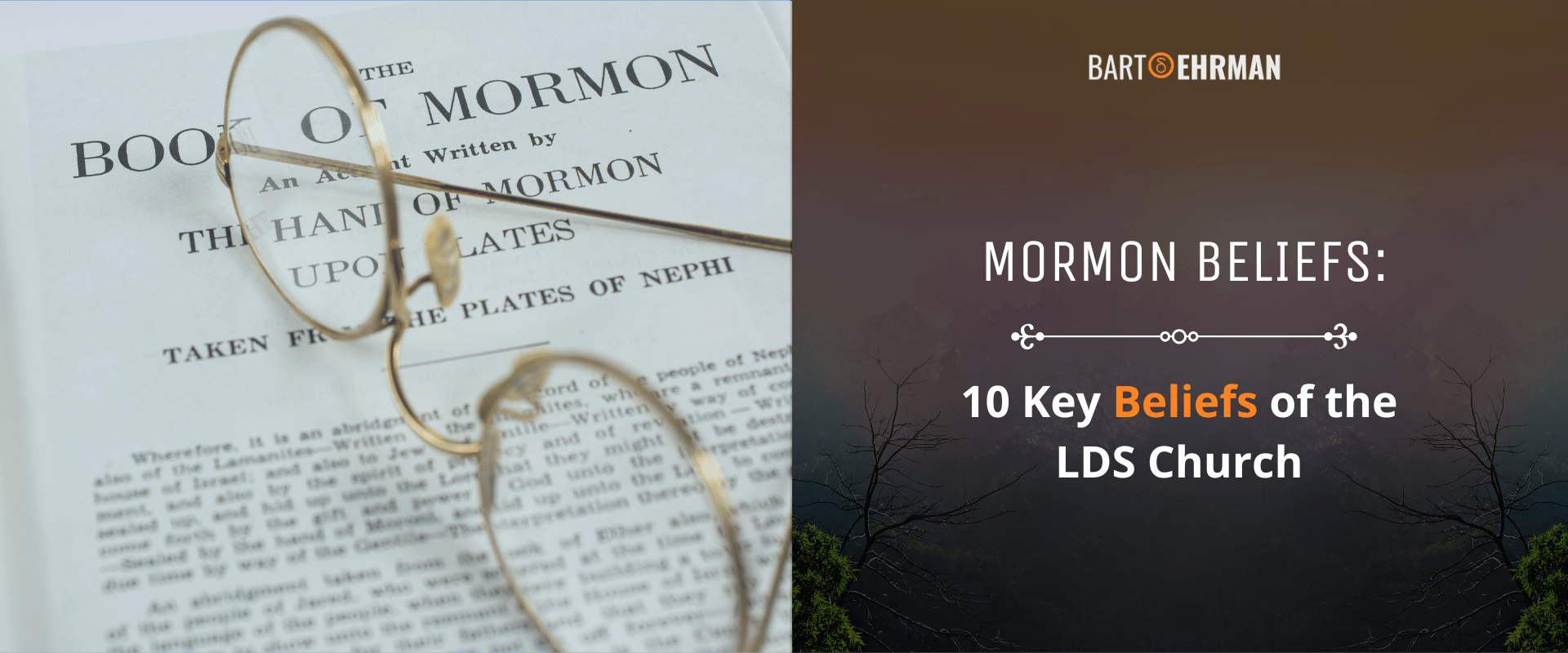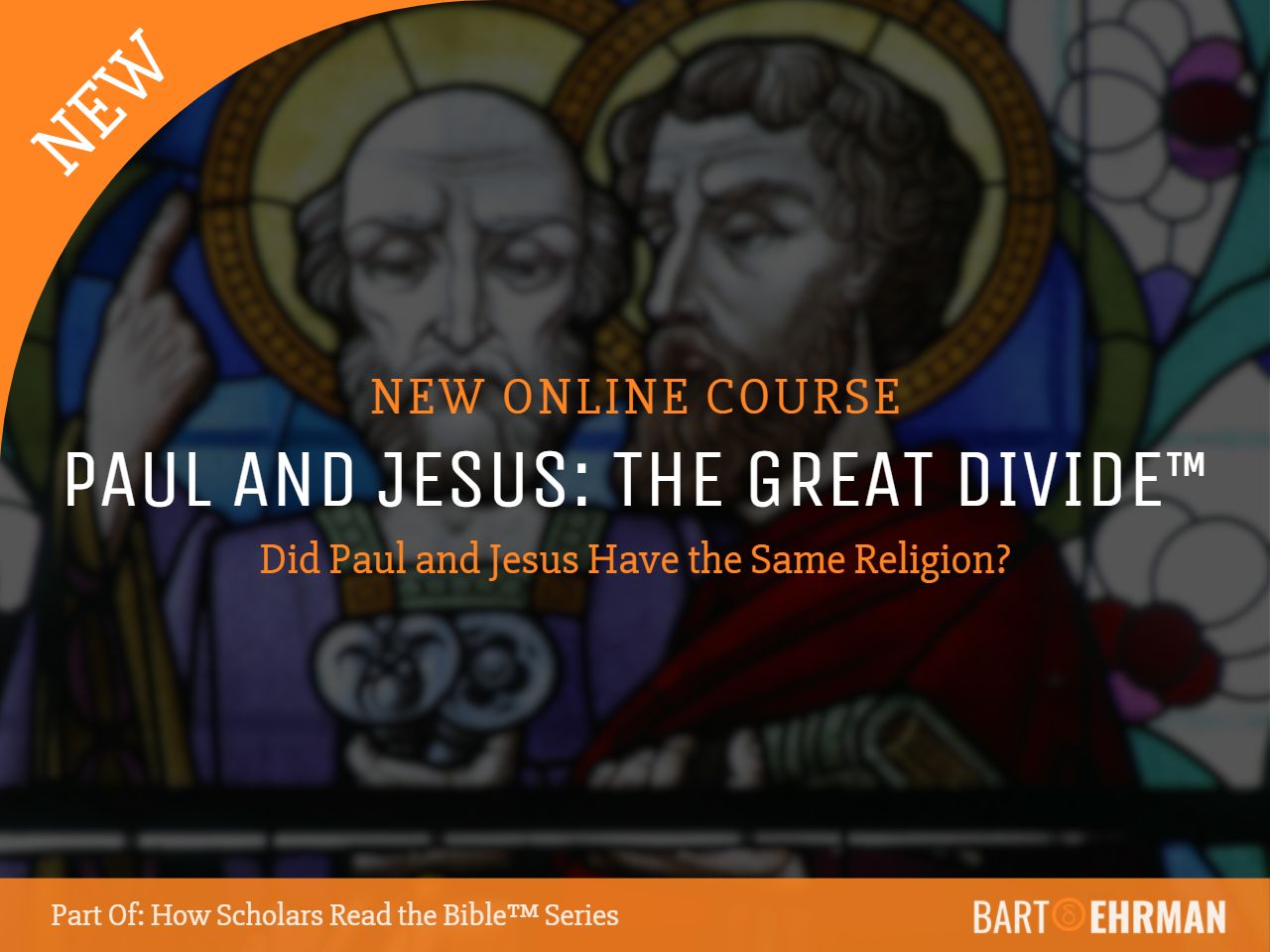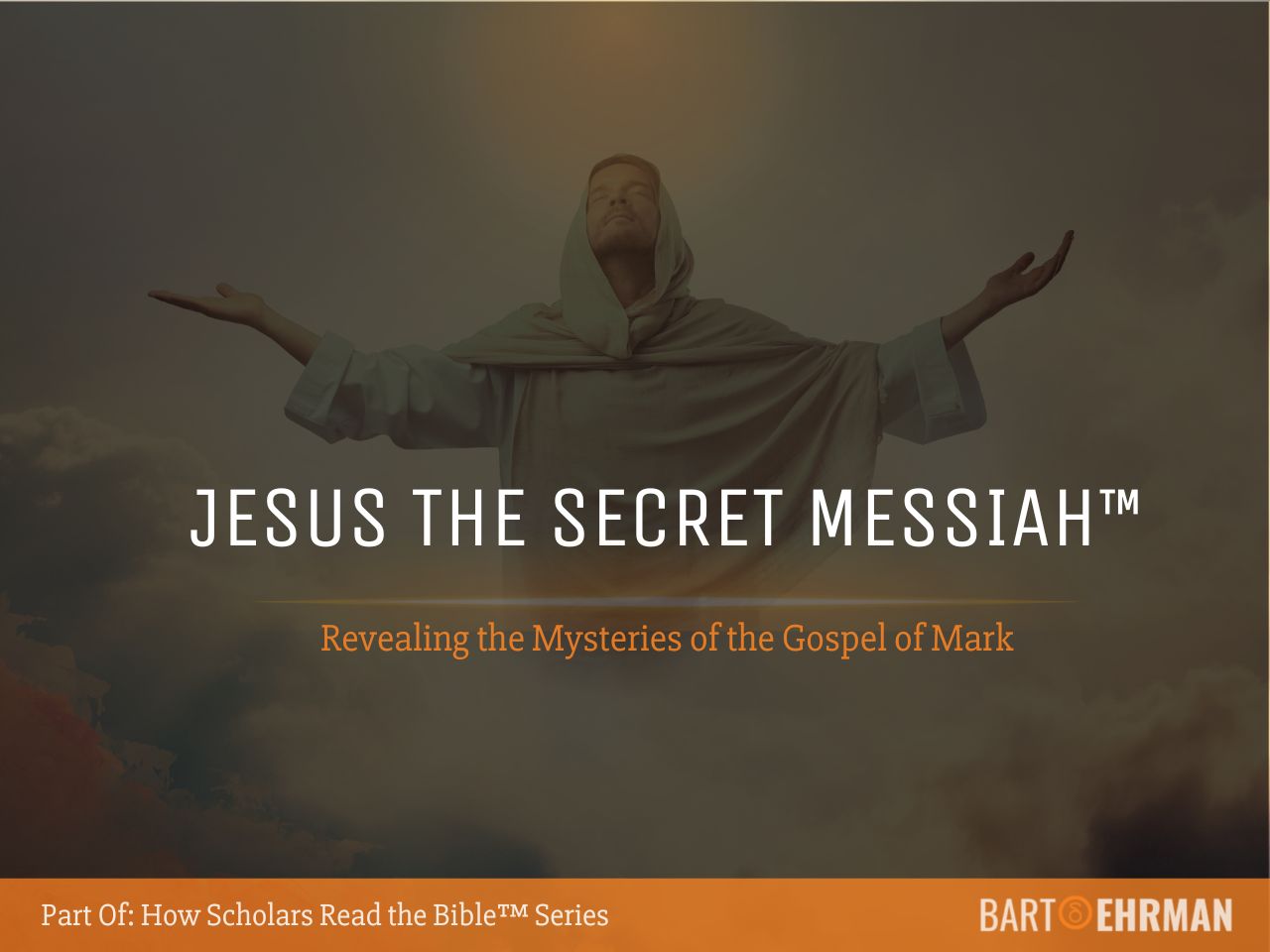Mormon Beliefs: 10 Key Beliefs of the LDS Church

Written by Marko Marina, Ph.D.
Author | Historian
Author | Historian | BE Contributor
Verified! See our guidelines
Verified! See our editorial guidelines
Date written: January 9th, 2025
Edited by Laura Robinson, Ph.D.
Disclaimer: The views and opinions expressed in this article belong to the author and do not necessarily match my own. - Dr. Bart D. Ehrman
Imagine if I told you about an extraordinary revelation I recently experienced. While casually watching TV, an angel appeared to me, giving instructions to write a new, updated version of the Bible.
The angel said this version would contain the ultimate truth about God, Jesus, and salvation. You probably wouldn’t believe me — and that’s perfectly reasonable. Yet, a similar origin story lies at the heart of Mormon beliefs, a religion that has historically experienced rapid growth and remains one of the world’s most fascinating movements.
Mormonism, or the Church of Jesus Christ of Latter-day Saints (LDS Church), began in the early 19th century with a young man named Joseph Smith. According to Smith, he had a vision of God and Jesus as a teenager, followed by a series of angelic visitations that culminated in the translation of sacred writings now known as the Book of Mormon.
What do Mormons believe? How do their views of Jesus, women, and other theological topics compare to mainstream Christianity? Their Church is built on a distinct set of tenets that set it apart, and understanding these beliefs offers a unique window into their world.
In this article, we’ll uncover the historical origins of Mormonism, explore its foundational teachings, and analyze its modern-day growth and influence. By delving into Mormon beliefs as well as the data behind their expansion, we’ll gain insight into a religion that has both captured imaginations and faced controversies.
Before we dive in, I encourage you to explore Bart D. Ehrman’s fascinating online course, “Paul and Jesus: The Great Divide.”
While many assume these pivotal figures shared the same religion and theological views, the reality is far more complex. Discover what contemporary scholars have uncovered — check out Dr. Ehrman’s course today!

Joseph Smith and the Beginnings of Mormonism
The Church of Jesus Christ of Latter-day Saints traces its origins to the 19th century. It was a time of fervent religious revival known as the Second Great Awakening, when a sense of religious excitement was on the rise.
In his book, An Introduction to Mormonism, Douglas J. Davies notes:
(Affiliate Disclaimer: We may earn commissions on products you purchase through this page at no additional cost to you. Thank you for supporting our site!)
Excitement is one answer to the question of why people give their lives to religion. It is one of the more neglected aspects of religious experience. Excitement stirs group worship in waves of passion, brings teenagers the force of unique identity, sustains the middle-aged during years of responsible duty, and to the aged brings memory and hope. Just as falling in love can, for a time, foster an intense sense of being alive, so can the awareness of being in contact with God.
Emerging from this spiritual hothouse, Mormonism introduced a set of distinctive beliefs that have shaped its identity and inspired devotion and debate.
Central to its foundation is the story of Joseph Smith Jr., a young man from rural Vermont whose visions and revelations laid the groundwork for what would become one of the fastest-growing religious movements in the world.
Joseph Smith Jr. was born in 1805 into a poor farming family with a deep interest in religion and folk traditions. The Smith family eventually settled in Palmyra, New York, in a region dubbed the “Burned-Over District” due to the intensity of religious revivalism.
Thomas F. O’Dea, in his sociological study of Mormon beliefs and origins, describes the cultural background of New York State at the beginning of the 19th century. He asserts:
It was the peculiar genius of the people of the area that everything they touched went to extremes. Temperance was embraced, and it came to mean total abstinence, including abstinence from wine and beer and, some suggested, from tobacco, tea, and coffee. Abolition became the demand that slaves be freed immediately, and all churches and Christians who stopped short of demanding immediate manumission were branded as the blackest sinners.
As a boy, Joseph was influenced by his parents’ fascination with dreams and their relentless search for a church that felt “right.”
In 1820, at the age of 14, Joseph retreated into the woods to pray for guidance amidst the religious discord of his time. It was there, he claimed, that he had a vision of God the Father and Jesus, who told him that all existing churches had strayed from true Christianity.
This experience became the cornerstone of Mormon beliefs and marked the beginning of Joseph Smith's role as a prophet.
Three years later, at the age of 17, Joseph described another pivotal encounter. He claimed that an angel named Moroni appeared to him, announcing that God had a great mission for him. Moroni directed him to a set of golden plates buried near his home, inscribed with a sacred text in an unknown language.
Alongside these plates were two stones, known as the Urim and Thummim, which Smith described as divinely prepared tools to help him translate the text. However, the angel didn’t allow him to take the plates immediately.
Richard Bushman, in Mormonism: A Very Short Introduction, explains that, according to later accounts, Joseph Smith initially doubted his vision when a supernatural force prevented him from retrieving the golden plates, despite seeing them clearly. The angel reappeared, admonishing Smith that his failure was due to mercenary motives.
It was only in 1827 that he was permitted to retrieve the plates and begin translating them. Interestingly enough, early Smith’s associates Oliver Cowdery, David Whitmer, and Martin Harris testified that they saw the angel Moroni and the golden plates.
To be more precise, they stated that the angel showed them the plates and that they heard the voice of God that affirmed their truthfulness. Later on, they left Joseph Smith and the Church, but none of them even denied their testimony!
In any case, Joseph’s efforts led to the publication of The Book of Mormon: Another Testament of Jesus Christ in 1830. According to Smith, the book was a record of ancient prophets who lived on the American continent and bore witness to Jesus Christ. Furthermore, the Native Americans are depicted in the book as descendants of the Israelites.
While Mormons accept this account as a foundational truth, scholars have long questioned the authenticity of Smith’s claims. Richard Abanes, for instance, has pointed out the numerous anachronisms and the fact that archeological evidence doesn’t align with Smith’s statements about the Native American tribes.
He asserts:
Here it must be noted that no professional non-Mormon anthropologist or archaeologist has ever given any merit to the idea that Native Americans are descended from Israelites. No evidence exists to support such a theory.
Regardless, the publication of the Book of Mormon marked the formal establishment of the LDS Church in the same year, with Smith as its first leader and prophet.
The Church of Mormons: Initial Establishment and Challenges
As the fledgling church grew, its members faced significant challenges. The Mormons settled in Nauvoo, Illinois, in 1839, where they prospered for a time under Smith’s leadership. The community attracted thousands of converts, including many from England, and even organized its militia.
However, Smith’s revelations — including the controversial practice of plural marriage — strained relations with outsiders. In 1844, a mob killed Joseph Smith, leaving the Church without its founder and leader.
Following Smith’s death, a succession crisis divided the church. Some followed his wife, Emma Smith, to form what is now known as the Community of Christ, while others rallied around Brigham Young, who led the majority of Mormons westward to Utah.
There, in the valley of the Great Salt Lake, they sought to establish a new Zion. Over time, the Church renounced polygamy and integrated into American society, evolving into a global religious community with over 15 million members today.
Richard Bushman aptly observes that Joseph Smith’s most remarkable legacy was the creation of the Mormon community itself. Even those who remain skeptical of Smith’s teachings often recognize the unique cohesion and solidarity of the Latter-day Saints.
Thomas F. O’Dea similarly noted that, among the various social groups that developed in America, the Mormons “came closer to evolving an ethnic identity on this continent than any other group,” highlighting their distinctive cultural and communal bonds.
And it all began with the story of Joseph Smith and his extraordinary religious experiences, which laid the foundation for Mormon beliefs. Having traced the fascinating history of its origins, let us now turn to the heart of the matter: The belief system that defines this unique faith tradition.
Mormon Beliefs: An Introduction
A couple of years ago, I had an intriguing conversation with a young Mormon missionary on the streets of Zagreb. Knowing that Croatia is predominantly Catholic, he introduced himself as a member of the Christian community, emphasizing his connection to the broader Christian tradition. However, this claim often sparks debate.
Many Christians are deeply unsettled when Mormons describe their faith as part of Christianity. Trent Horn, speaking from the Catholic perspective, concludes, for example, that Mormons are “so alien to the Christian belief that they essentially belong to another religion.”
To these critics, Mormons represent an entirely distinct religion, primarily for three reasons:
Without taking sides in this debate, it’s worth noting how those in established religious traditions often react to new movements with skepticism, quickly questioning their identity markers.
One can almost imagine ancient Jewish leaders in Jerusalem scoffing at early followers of Jesus who identified themselves as Jews: “They still go to the Temple but with their Christology? They aren’t Jews! No way!” History has a way of repeating itself when drawing lines around religions. That being said, let’s take a closer look at the Mormon beliefs.
What Do Mormons Believe? Scripture, Tradition, and Salvation
Mormon beliefs encompass a rich tapestry of teachings, many of which diverge significantly from the major branches of Christianity. Central to these differences are the role of scripture, the nature of God and humanity, and the specific practices that shape the daily lives of Latter-day Saints.
Scholarly Insights
Miracles, Evidence, and the Pandora’s Box
Many Christian apologists argue that the resurrection of Jesus is remarkably well-attested in the surviving historical sources. It’s fascinating to compare the so-called “strong evidence” for Jesus’ resurrection with supernatural claims from other religious traditions. The story of the angel Moroni’s appearance to Joseph Smith and the Three Witnesses provides an intriguing parallel worth exploring.
In the case of Jesus’ resurrection, the only firsthand account we have comes from the apostle Paul, who briefly describes his religious experience of seeing the resurrected Jesus on the road to Damascus. Other accounts about the resurrection come from second (Paul) or third-hand sources, often written decades later by unknown Christian authors who contradict each other in several details.
Now, consider the appearance of the angel Moroni: We have not only Joseph Smith’s testimony but also three separate witnesses — Oliver Cowdery, David Whitmer, and Martin Harris — who personally signed statements claiming they saw the angel and the golden plates. By the standards often applied to the resurrection story, this would appear to be an unusually well-documented supernatural event.
If we, as historians, apply the same evidentiary standard Christian apologists often use for their tradition, a Pandora’s box begins to open. Scholarly analysts, therefore, must always remain cautious and skeptical when dealing with the supernatural. Because once we let the camel’s nose of miracles into the tent of serious scholarship, we may find ourselves surrounded by a herd of supernatural claims, all vying for equal consideration.
One of the most defining features of Mormon beliefs is their embrace of additional holy scriptures. Alongside the Bible, Mormons hold the Book of Mormon, Doctrine and Covenants, and The Pearl of Great Price as sacred texts.
Davies explains:
The early text – the Book of Mormon – was published in 1830 and expressed a general Christian doctrine of salvation rooted in repentance, faith, and baptism, all framed by a dynamic millenarian expectation of an imminent return of Christ. For this Christians should prepare by gathering together. The later texts – the Doctrine and Covenants (1835) and the Pearl of Great Price (1851) – take Mormonism into the new theological territory of covenant-making temple ritual, the conquest of death by persons set on the eternal path of apotheosis or of becoming divine.
Furthermore, the Mormon Church believes its leaders — Smith’s successors — are modern prophets capable of issuing teachings on par with scriptural revelation. This expanded canon of scripture contrasts sharply with both the Protestant principle of “Sola scriptura” and the Catholic view of the closed Scripture.
Historically, one of the most controversial aspects of early Mormonism was the practice of polygamy. Around 1831, Joseph Smith claimed to have received a revelation instructing Mormon men to marry multiple wives, citing the examples of Israel’s patriarchs.
Yet this innovation, as O'Dea notes, was important to Mormons for other reasons. Not only did it set them apart from gentiles more definitely and more definitively than anything else they had done, but all Mormon doctrinal innovations were to fall into place around this new teaching on marriage. The Mormon doctrine of marriage made sexuality a means to celestial glory.
However, the introduction of this practice was fraught with conflict, even within the community. Smith secretly entered into polygamous marriages — allegedly taking between 30 and 40 wives, some of whom were already married or very young — before publicly announcing the doctrine.
Unsurprisingly, this revelation caused considerable outrage, including resistance from his wife, Emma, who initially sought to mobilize Mormon women in protest. Although Mormons officially abandoned polygamy in 1890, the association between their Church and plural marriage continues to shape public perceptions of this religion.
In his book Mormon Polygamy: A History, Richard S. Van Wagoner traces the changing status of polygamy:
As barren and distant as the region seemed, it was not far enough away to avoid four decades of public outcry after the Mormon church officially announced in 1852 its advocacy of polygamy. This lengthy protest, and the accompanying government pressures, influenced church president Wilford Woodruff to issue a public announcement in 1890 that advised members against contracting new plural marriages. Church-sanctioned polygamy continued on a covert basis until 1904, however, when President Joseph F. Smith, under congressional pressure, authorized the excommunication of all who continued to perpetrate the practice.
What Do Mormons Believe About Jesus and Salvation?
One of the most fascinating aspects of Mormon theology is its understanding of God, humanity, and Jesus. Traditional Christianity teaches that God is wholly separate from human beings and is one in essence, existing as a Trinity of Father, Son, and Holy Spirit.
Mormon beliefs, however, depart significantly from these doctrines. Joseph Smith taught that God was once a mortal being who achieved exaltation and is now an “exalted man” with a physical body of flesh and bone.
What do Mormons believe about Jesus’ identity and importance? While Jesus is central to their theology, their understanding of him differs from traditional Christian teachings. Mormons view Jesus as the literal Son of God, the most exalted of God’s spirit children, who holds a unique role in salvation.
Unlike mainstream Christian doctrine, which emphasizes Jesus as fully God and fully man in a paradoxical union, Mormon theology presents him as a divine figure distinct from God the Father. His atoning sacrifice is considered vital, but salvation isn’t solely dependent on faith in Jesus; it also involves personal righteousness and adherence to specific practices.
Mormon beliefs about salvation reflect a complex framework known as the “plan of salvation.” While faith in Jesus is foundational, salvation requires a life of righteousness guided by adherence to LDS teachings.
This includes observing dietary restrictions, such as abstaining from alcohol and coffee, treating the body as a sacred temple, and tithing — donating 10% of one’s income to the church.
Mormons also emphasize the importance of temple rituals, which are central to their spiritual life. These rituals, performed in temples not open to the public, include the “endowment,” where members learn about salvation and make covenants with God, and “sealing,” which unites families for eternity.
Referring to the former ritual, Richard Abanes explains:
This highly secretive rite continues to be practiced today by faithful Mormons as an indispensable prerequisite to achieving godhood. Until April Of 1990, the ceremony actually contained death penalty oaths to keep Mormons from revealing LDS ceremony secrets (similar to the oaths taken by Freemasons against revealing Masonic secrets). These bloody Mormon vows were exposed in 1906 by the Salt Lake Tribune, then reprinted by W.M. Paden in Temple Mormonism (1931).
The Mormon Church presents a worldview that blends ancient scriptural traditions with modern revelations through these distinctive beliefs and practices. Whether viewed as an extension of Christianity or a wholly distinct religion, Mormon beliefs offer a unique lens through which to explore questions about religion, community, salvation, and the divine.
What Do Mormons Believe About Women?
The role of women in Mormon beliefs and practices is both significant and at times the subject of debate among scholars and observers. Women play an important role in the LDS Church, especially in family life and spiritual development, where they are often seen as central figures in the fulfillment of God’s plan.
Mormon theology emphasizes the concept of “eternal families,” where women, as wives and mothers, play an essential role in raising children, maintaining households, and supporting their husbands in both spiritual and practical matters.
However, unlike men, women in the Mormon Church aren’t permitted to hold the priesthood, which is considered the authority to perform sacred ordinances, lead congregations, and administer church functions.
For that reason, Davies notes, the organization of the LDS Church, as well as its history, is a faith history of great men, and of some great women, but the men predominate.
In recent years, Mormons have taken steps to address concerns about gender roles, highlighting the spiritual equality of men and women within God’s plan. Leaders emphasize that women possess unique spiritual gifts and are integral to the church’s mission and growth.
While debates surrounding women’s ordination and leadership persist, Mormon females continue to occupy influential roles as teachers, missionaries, and leaders within women’s and youth organizations.
In an interview, Terryl Givens from the University of Richmond notes the paradoxical nature of women’s position:
I think the role of women in the LDS Church and LDS theology is something of a paradox. To an outsider what is most immediately apparent is that the priesthood is limited to men and that there are no women who officiate in the church. Even an institution like polygamy seems to privilege the man over the woman. Yet at the same time, there are many threads in Mormonism that move very, very sharply in the opposite direction. It is clear, for example, that the Mormons were ahead of their time in emphasizing the need and the desirability of women obtaining an education. They gave the vote to women, and women, in fact, ended up being the first to exercise that vote in the state of Utah before Congress took it away again when they didn't like the way they used that vote.
Do Mormons Have Any Crazy Beliefs?
The question of whether Mormons — or any religious group — hold “crazy” or “weird” beliefs is a matter of perspective. “Crazy” or “weird” concepts are highly situational and subjective, shaped by cultural norms, personal experiences, and individual worldviews.
Sociologists and anthropologists refer to such labels as “emic” terms — developed by outsiders to describe groups or individuals they perceive as “other.” While such descriptions might reflect a particular viewpoint, they hold little value in scholarly analysis, which seeks to understand belief systems objectively rather than judge them through the lens of personal bias.
To put this into context, consider some of the beliefs and stories found within mainstream Christianity. For a non-believer, or someone unfamiliar with its traditions, certain elements might appear puzzling, unusual, or even outlandish.
A talking serpent in the Book of Genesis? Earthquakes accompanied by saints rising from their graves in the Gospel of Matthew? And what about the central doctrine of Christianity itself — the resurrection of a man who had been dead for three days?
For someone with a strictly materialistic or atheistic worldview, these concepts might sound “crazy” or implausible. Yet for millions of Christians, they are sacred truths central to their religion.
The phenomenon isn’t limited to religion. Non-religious ideologies, such as political movements, have also been known to inspire practices and beliefs that might strike outsiders as strange. Consider Soviet Communism, a movement often analyzed for its “quasi-religious” qualities.
In his thought-provoking book Komunizam kao religija (Communism as a Religion), Mihail Riklin explores the rituals, symbols, and belief systems embraced by Soviet communists — elements that, to an outside observer, might seem as “crazy” even more than any religious doctrine.
For this reason, a scholarly approach to the study of religion categorically rejects such terms and judgments.
Instead, scholars strive to understand religious beliefs, practices, and rituals from multiple perspectives: both from the inside, as experienced and explained by believers themselves, and from a broader, bird’s-eye view that considers their cultural, historical, and social contexts.
Thus, as a historian and scholar of religion, I reject the idea of labeling any belief system as inherently “crazy” or “weird.” Mormonism, in particular, represents a fascinating and significant aspect of the religious landscape of the United States.
It has often been described as “the most American religion”— a pioneering faith that emphasizes free will, personal revelation, and family as core values.
Whether one agrees with Mormon beliefs they deserve to be studied and understood with the same care and respect that we extend to any other religious tradition. After all, what may seem “strange” to one person is often deeply meaningful to another.

The Growth of Mormonism: Sociological Perspective
An important aspect of Mormons' beliefs is their emphasis on missionary work. For members of the community, going on a mission isn’t just encouraged; it’s considered a rite of passage. Every healthy young man is expected to serve a two-year mission starting at age 18. These missions are a cornerstone of Mormon life, similar to, for instance, Jehovah’s Witnesses.
From its humble beginnings in the early 19th century with just a handful of followers, the LDS Church grew exponentially throughout the 20th century. By the century’s end, its membership had swelled to over 10 million members worldwide, making it one of the fastest-growing religious movements in modern history.
Today, the church boasts more than 15 million members and a presence in nearly every country. This remarkable expansion prompts a compelling question: How do we explain the extraordinary growth of the LDS Church?
Part of the answer lies in the leadership of the LDS Church during its formative years. Joseph Smith is often described as a religious genius. Contemporary accounts highlight his remarkable charisma and ability to connect with people on a deeply emotional and spiritual level.
After Smith’s death, Brigham Young emerged as a skilled organizer and pragmatic leader who guided the church westward and established a strong, cohesive community in Utah, laying the groundwork for future growth.
Another key factor is the LDS Church’s (already mentioned) devotion to missionary work. Missionaries go to great lengths to share Mormon beliefs with people from all walks of life, fostering a culture of outreach that has brought countless converts into the fold.
A third reason for the church’s success is its ability to create a distinct and cohesive culture that inspires deep loyalty among its members. Being Mormon isn’t merely about attending church services twice a year (what British sociologist Grace Davie would call “believing without belonging”) or holding a mixed bag of beliefs. Rather, it’s a full identity that permeates every aspect of life.
Research by sociologists Rodney Stark and William S. Bainbridge further illuminates the dynamics of Mormon conversions. Their study, published in The Future of Religion, reveals that conversion is rarely the result of a random encounter, such as a door-to-door visit by missionaries.
Instead, it often stems from personal connections. Stark and Bainbridge found out that when missionaries made initial contact with individuals in the homes of Mormon friends or relatives, the likelihood of conversion skyrocketed to 50%.
This discovery demonstrates the importance of social ties in religious growth; strong personal attachments to members of the LDS Church often outweigh existing relationships outside the group, paving the way for successful conversion efforts.
And if the PEW study from 2014 is accurate, Mormonism continues to thrive, with over 80% of its members stating that their religion is very important to them — a stark contrast, for instance, to the 58% of Catholics who say the same.
Finally, Davies summarizes the reasons for the growth of Mormon religion in the following way:
The birth of the Church lay in Joseph Smith’s prophetically charismatic millenarian message, which was complemented by the publication of the Book of Mormon, itself a prophet-filled volume; the Church’s survival and subsequent flourishing were fuelled by a growing population who were sustained by values generated by formal ritual, which was introduced after the founding of the Church and was informed by ideas that came to fruition, for example, in the Book of Abraham in the 1840s.
10 Key Mormon Beliefs: Chart
We thought you might appreciate a quick cheat sheet before we wrap up our exploration into the Mormons' beliefs and practices.
Because, let’s face it, understanding religious doctrines can sometimes feel like studying for a final exam you didn’t know you signed up for! Below is a table highlighting 10 key Mormon beliefs that offer a concise yet scholarly glimpse into what makes this faith tradition so distinct.
Belief | Description |
|---|---|
Scriptures Beyond the Bible | Mormons accept the Book of Mormon, Doctrine and Covenants, and Pearl of Great Price as holy scriptures alongside the Bible. |
God Was Once a Human Being | Joseph Smith taught that God was once mortal but achieved exaltation and now has a physical body of flesh and bone. |
The Social Trinity | Unlike traditional Christian denominations, Mormons believe the Father, Son, and Holy Spirit are distinct beings, united in purpose but not essence. |
Jesus as the Literal Son of God | Mormons view Jesus as the literal Son of God, a distinct divine being who enables humanity's salvation. |
Salvation | Salvation requires faith in Jesus but also living a righteous life, following particular rules, and performing specific rituals. |
Eternal Families | Families are central to Mormon theology; temple rituals seal families together for eternity, uniting them beyond this life. |
The Word of Wisdom | The LDS Church teaches a health code prohibiting alcohol, coffee, tea, and tobacco. |
Modern Prophets and Revelation | Mormons believe in continuing revelation, where modern-day prophets, starting with Joseph Smith, guide the church. |
Temple Ordinances | Key temple rituals include endowment (spiritual teachings and promises) and sealing (eternal marriage and family unity). |
Missionary Work | Missionary work is a (obligatory) cornerstone of Mormon practice. |
Conclusion
Reflecting on my conversation with the young Mormon missionary on the streets of Zagreb, it becomes clear that Mormonism's appeal lies not only in its unique history but also in the distinct theological framework that underpins its identity.
The LDS Church has carved out a significant place in the global religious landscape, blending 19th-century American revivalist enthusiasm with teachings and practices that continue to inspire devotion among millions of followers.
Finally, understanding Mormon beliefs, from their expanded canon of scripture to their emphasis on family and missionary work, offers valuable insights into how this religion has evolved and thrived despite challenges and controversies. It will be interesting to follow up on sociological stats and curves of Mormonism in the years ahead.


